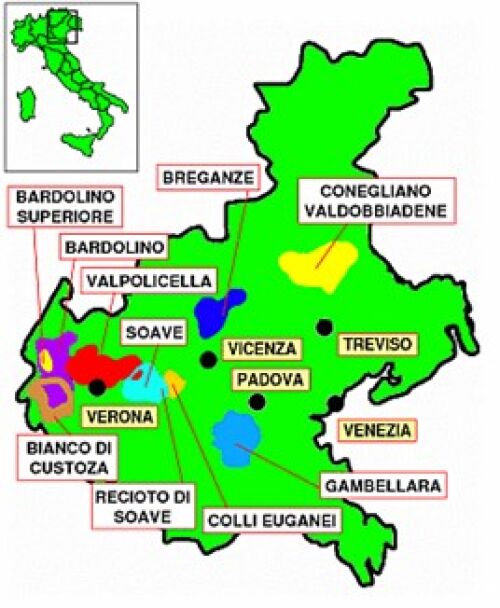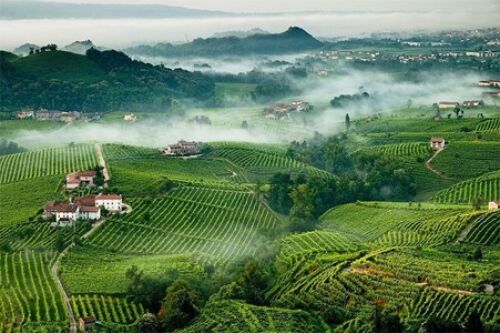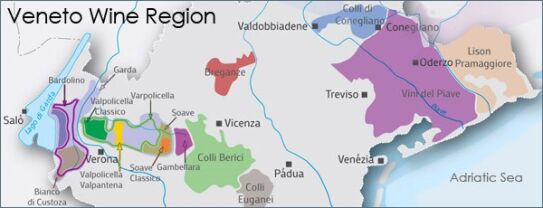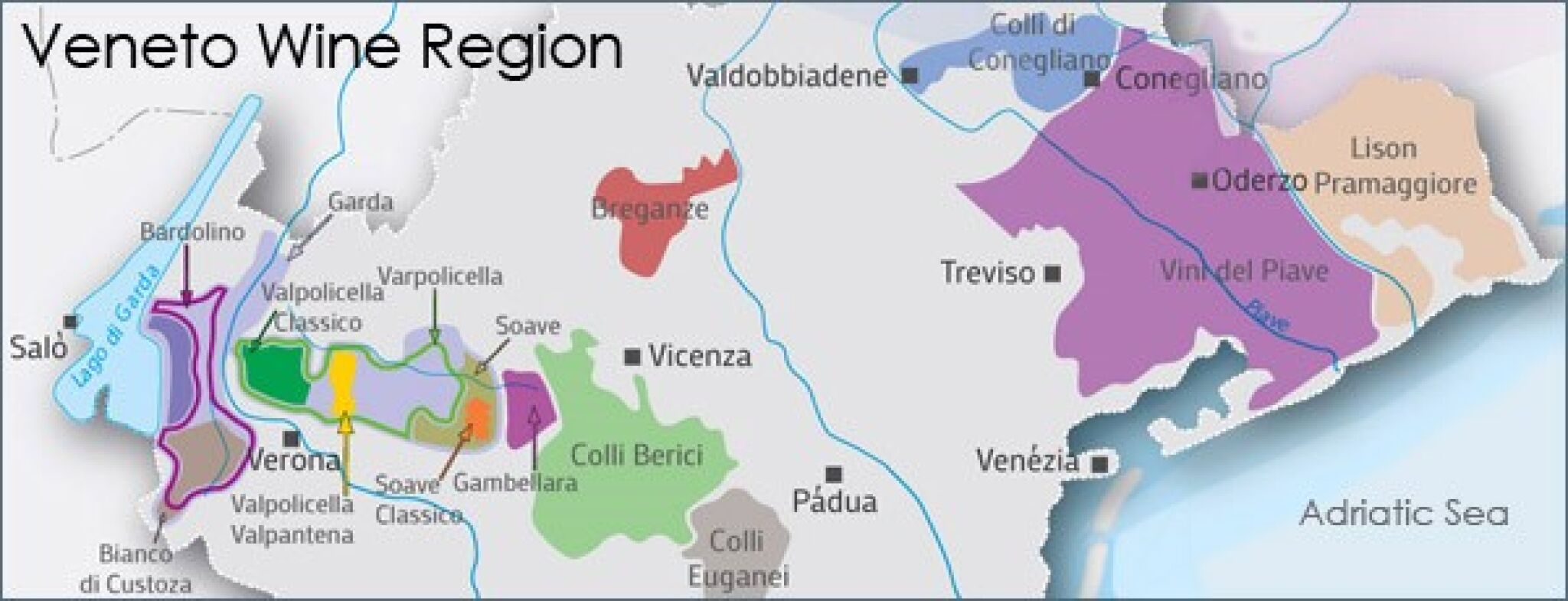by Nick Adams MW
Italy is one of the most important wine producing countries and especially so for the UK market and the HoReCa trade channel in particular. The importance of the Prosecco market alone is testament to that fact. But there is the most amazing diversity to this country, and it remains home to the largest population of indigenous grape varieties and styles. In a series of blogs, I will look at the most important areas and highlight wines from the Peter Graham portfolio for you to try. We start by looking at the region responsible for Prosecco (and much else) - Veneto. But first, a brief introduction to the country.
Introduction to Italy
Italy vies with France each year as the single largest wine producing nation in the world. As a country, Italy (formally founded 1861) only became a united entity in the 1870s and there is still some “fragmentation” between regions now, with many operating as quasi countries within a country, so to speak.
The delimited DOC and DOCG (“Garantita”) production areas were first defined in 1963 - currently there are 330 DOCs and over 77 (and growing) DOCGs, with the generic IGT (Indicazione Geographica Tipica – or IGP now) underneath.
Italy also uses terminology peculiar to the country – not least “Classico” referring to the heartland – or supposedly best vineyard areas within a DOC(G) – eg Soave, Chianti, Valpolicella. The term Riserva usually refers to higher quality selected wines (often with more oak and bottle aging) but does not carry the definition or legal obligation as is found in Spain for example.
Passito or Appassimento refers to the Italian speciality of air drying the grapes (for 3-6 months) to increase levels of sugar and concentration (and in the case of black grapes, tannins, and colour) with the resultant wines. The spiritual home for this process is Veneto.
In vine growing and winemaking terms, Italy is unique in that, with two exceptions (the white grapes Trebbiano and, of course, Pinot Grigio), the grapes grown, and wines made, are often unique to that declassified area.
The country is so elongated that at its most northern tip you are level with Burgundy (to the west) in France, whilst at its most southern point you are below the North African coast. In addition, large parts of Italy are mountainous/hilly, which combined with its ever close presence to water makes for an incredible series of micro- climates. In addition, the soil is very old and weathered so little surprise that nearly every region’s wines are so individual.

A famous region with the historic cities of Verona as its centre and Venice on the coast. This is the production centre for vast quantities of Pinot Grigio and of course Prosecco. Whereas the vast majority of Italy is mountainous – or at least hilly – this area is quite flat – and it is on these fertile plains that high cropping vines can be found where wines are made to hit certain price points shall we say.
Image left: The rolling Glera vineyards in Prosecco
With regards to Prosecco - which is made from the Glera grape - this is made across a vast swathe or vineyards to the east of the centre of the province, around Treviso, but there is a delimited higher quality vineyard area Conegliano Valdobiaddene. Here the microclimate and soil produce the finest Glera grapes and there is a noticeable increase in quality and concentration. There are no real super star producers, but these wines are generally worth the premium. Within Valdobiaddene there is a special enclave called Cartizze, which is produce the finest Glera and Prosecco of all. But these are expensive.

Prosecco is made in sealed tanks and exemplifies a clean, crisp, and fruit led sparkling wine style – no wonder it is so popular. There is also a Rosé (rosato) style produced - by law now the only black grape which can be used is Pinot Noir (Pinot Nero) and at least 85% of the blend must still be Glera.
The majority of Prosecco is “Spumante” in style - by that fully sparkling - but you can also find “Frizzante” styles which are gently sparkling and said to work better with food.
Please find 3 fine styles below - including an organic white example, a rosé, and the superior vineyard selected example from Valdobbiadene.

Prosecco Examples
Still Wines
As for still wine the two most important areas and neighbours are Soave (white) and Valpolicella (red). The basis of top quality Soave is the Garganega grape, although a superior clone of Trebbiano is used in a lot in blends. With Valpolicella the most important grape is Corvina, but this is often blended with Rondinella and Molinara in differing proportions. In addition, several quality producers also rate and use the Oseleta.
Stylistically Soave is a relatively gentle and softly fruity white wine, mainly unoaked and with nutty overtones and medium to medium plus acidity. With age it develops remarkably concentrated honey and camomile flavours and can age well for 5 or more years in top examples.
Valpolicella is often loosely referred to as “the Beaujolais of Italy” which might relate to its structure rather than flavours, as at its generic table wine level it has low levels of tannin and a soft juicy, cherry fruit character. These wines are made for early drinking and can be very enjoyable.
One of the interesting aspects of these two regions has been how they have used and adapted air-drying methods for grapes – a process which is called “Appassimento or Passito” as it creates desiccated shrivelled grapes which are higher in sugar, lower in water content and more concentrated in flavours – and in Valpolicella’s case tannins and increased colour pigments in the grape skins. This process can of course be accentuated with later harvesting dates. Historically grapes were laid out on straw mats and air dried in warm lofts for a number (up to 6 months), then crushed and fermented in the winter. In Valpolicella this process is accelerated via the use of giant air fans, some of which can even be set up to move around the drying trays.
Image Right: Corvina grapes post 5 months air drying - about 40% of the grape content is lost which is mainly water
If the wine is then fermented out dry the result is a much darker, richer, and fuller bodied style - this is called Amarone Valpolicella. If the fermentation is stopped then natural residual grape sugars remain in the wine - so its is sweet (but not too sweet) - these are called Recioto - both for Valpolicella and Soave. Recioto Valpolicella often drinks like a Port but without the high spiritous kick. There is a “half-way house” style called “Ripasso” which stylistically is between straight Valpolicella and Amarone. Top producers these days make this style from semi (rather than fully) dried grapes.
Clearly Soave can also benefit from late harvesting and - even in some years – a touch of botrytis (noble rot). Recioto Soave is a luxuriant sweet wine, more honeyed and waxier with elevated stone fruit character.
A nice mix here of styles - a refined Garganega based Soave, juicy and accessible straight Valpolicella from the Tedeschi family, and a rich, savoury Amarone.

Still Wines
Pinot Grigio
Finally, we cannot finish without a look at the ubiquitous Pinot Grigio from Veneto. Whilst quality can be variable here better example showcase well this grapes versatility and easy drinking profile. And it can be made in a rosé style too. Usually picked early and fermented out dry without any oak it delivers notes of melon, pear, and lemon in good examples. It is the epitome maybe of the easy drinking, apéritif, summer quaffer which is the bedrock of most on trade by the glass options. And how rosé?
The clue is in the name - Grigio. This means grey in Italian, as when the grapes ripen, they take on a coppery or rusty colour in their skins. This is because the grape is a mutation of Pinot Noir and has black grape heritage in its gene pool. Therefore, all you need to do is ensure both skins and juice are in contact, and you have a rosé version which also has a little more texture.
Please find both examples below under the San Antonio label.





